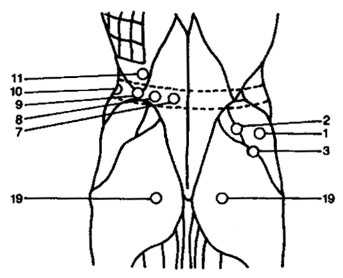
‘Pain erasure – The Bonnie Prudden Way’
The term ‘Myotherapy’ was developed by Bonnie Prudden. Prudden was an American pioneer in physical fitness and health. Prudden developed Myotherapy in 1976 as ‘a method of relaxing muscle spasm, improving circulation and alleviating pain’.
Prudden credited three key individuals in the 1940s who inspired her to develop Myotherapy. The first was her mentor, Hans Kraus who taught her the techniques of Corrective Exercise. The second was Janet Travell – who researched trigger point pain mapping. The third was Desmond Tivy who encouraged her research and coined the term ‘Myotherapy’ for her.
Before her discovery of the Myotherapy Method, she was a professional rock climber and mountaineer. Active outdoors, Prudden suffered several serious injuries in her life that resulted in crippling pain. She tried a range of treatments including injections, exercise, and meditation to ease her condition. Myotherapy was developed to manage her pain. Prudden tested the techniques on herself, staff and friends. She was successful in mapping out common pain triggers and the corresponding corrective exercises to fix each pain trigger.
Bonnie Prudden Myotherapy® was the topic of her 1980 bestseller ‘PAIN ERASURE: THE BONNIE PRUDDEN WAY’. It is the building block of Myotherapy today.
What is Myotherapy?
Myotherapy is a non-invasive, drug-free ‘pressure point’ treatment to manage musculoskeletal pain and to speed recovery. Myotherapy relaxes the muscles, improves blood circulation to sore areas to reduce inflammation and reduce pain. Specific corrective exercises used with pain trigger point treatment further builds strength, flexibility, coordination, stamina, and energy.
Myotherapy employs a wide range of techniques including:
- Massage (sports, remedial, deep tissue and others)
- Passive stretching (moving the affected body part through a range of motions)
- Hot and cold compresses
- TENS therapy (transcutaneous electrical nerve stimulation)
- Trigger point therapy (acupressure)
- Myofascial dry needling
What can Myotherapy treat?
Conditions such tightness and pain in the head, back, shoulders and neck, muscle tension or spasm. It can also help relieve the symptoms of carpal tunnel syndrome, fibromyalgia and arthritis, pre and post-natal discomfort.
Myotherapy is excellent to help resolve issues arising from sports injuries such as aiding muscle elasticity, reduce soft tissue swelling, and breakdown of scar tissue after injury.
Myotherapy should be considered for other common conditions such as:
– Frozen shoulder
– Tennis elbow
– Tendinitis
– Groin strain
– Lymphatic congestion
– Piriformis syndrome
– Cartilage damage
– Hamstring injuries
– Pre and post-surgery
What happens when you attend a Myotherapy session?
Myotherapy begins with a patient assessment to find out the underlying issues of your particular muscular pain. You will need to give them information about your medical history, prior illness, allergies and any surgery you may have undertaken. You will also need to give them a list of medications you are taking. Information provided during Myotherapy assessment is strictly confidential and the Massage Centre or Spa is bound by the Australian Privacy Act to keep this information safe. The assessment usually ends with a discussion of a treatment plan that can address your specific problem.
During the session, you must loose-fitting clothing, be shoeless and to stay relax as you lie on a table. The therapist will check the body for areas of potential active trigger points. Trigger points are highly irritable spots in muscles that have sustained injury or damage. When pressed, these points send pain receptors to the body. Depending on your condition, the therapist may refer you to other healthcare professionals for further treatment.
To find pain triggers, the therapist will manipulate joints and muscles, and test reflexes. Once trigger points have been identified, the therapist will begin treatment by applying pressure to diffuse the triggers. To do this, the therapist will use elbows, knuckles or fingers held over the point for several seconds at a time. Following this, a series of specific corrective exercises (for example massage and stretching) are used to loosen and free the muscles.
How frequently should you have Myotherapy?
The duration of the treatment depends on your massage therapist. An initial consultation is usually 90 minutes to 120 minutes long. Time is needed to correctly identify all the pain trigger points in your body to ensure successful treatment. The duration of the treatment depends on the nature of the injury. Your therapist will be able to advise you on an estimated period.
Myotherapy could be your answer to a pain-free life. Book your Myotherapy session with Retreat Wellness Massage Spa and erase pain from your life today.
